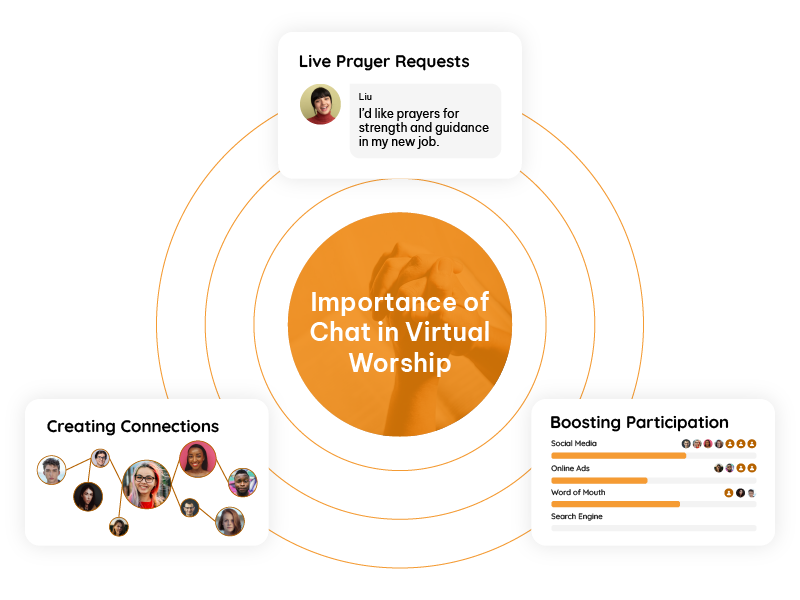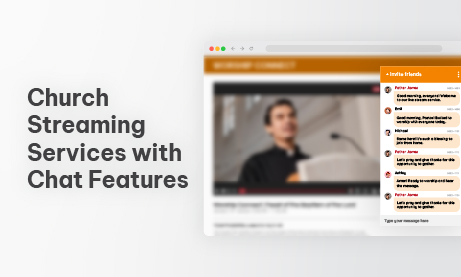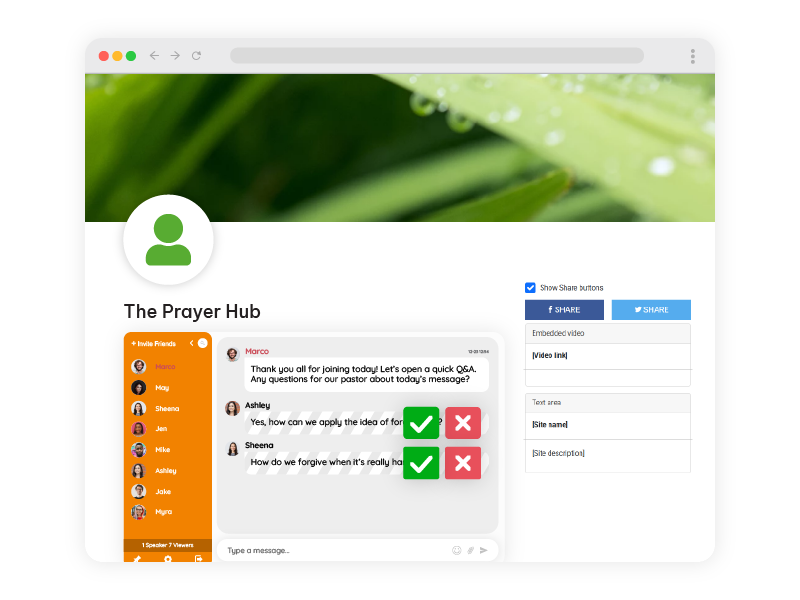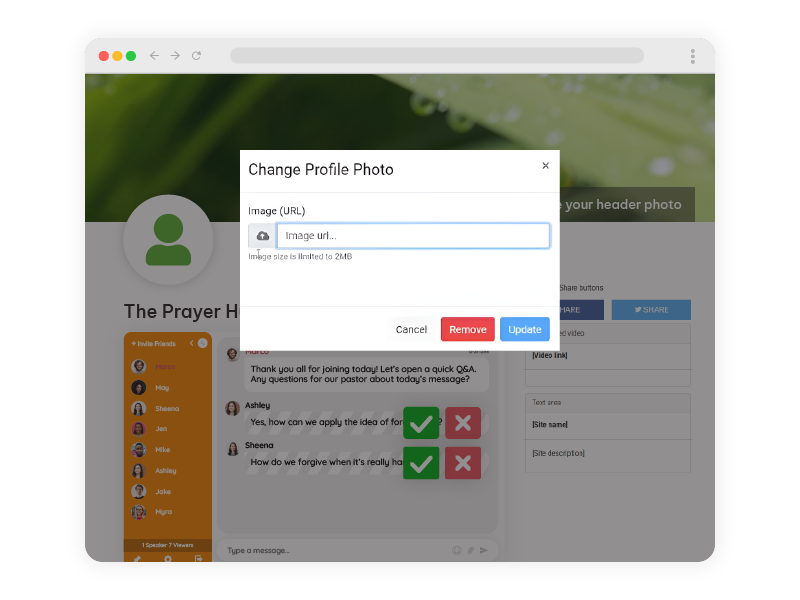As virtual worship continues to grow in popularity, many churches are discovering that simply streaming a service is no longer enough to engage their congregation. People yearn for connection, even in digital spaces, and chat features are one of the most effective ways to make virtual services more interactive and meaningful.
This guide explores how churches can integrate chat features into their streaming platforms, the benefits they bring, and how to implement them successfully.
The Importance of Chat in Virtual Worship
Virtual worship offers convenience and accessibility, but it can sometimes lack the sense of community found in in-person gatherings. Adding a chat feature bridges this gap by fostering real-time communication among attendees.

Creating Connection Through Chat:
Worshipers can exchange greetings before the service starts, much like they would in a church lobby. Moreover, a chat allows attendees to share reflections or favorite Bible verses during sermons, sparking conversations that deepen understanding.
Live Prayer Requests:
A dedicated prayer team can monitor chat for requests and respond immediately, creating a powerful spiritual connection. Congregants can also offer prayers for one another, reinforcing communal faith.
Boosting Participation:
Polls or quick questions during sermons (e.g., “What does this verse mean to you?”) encourage engagement. Furthermore, congregants can submit questions for pastors to address live, making the service feel interactive. These chat features help replicate the warmth and interaction of in-person worship in a digital format.
Embedding a Chat Room: A Seamless Worship Experience
Embedding a chat room directly into the streaming platform ensures that worshipers can engage without distractions or the need to navigate multiple tabs.
Why Embedded Chat Works:
– Worshipers can follow the sermon while participating in discussions without navigating to other platforms.
– Centralizing communication encourages focused engagement on the sermon and worship themes.
Best Practices for Embedding Chat:
1. Ensure Accessibility: Design the chat for both desktop and mobile platforms to cater to all worshipers.
2. Offer Customizable Options: Allow participants to toggle chat visibility or adjust font sizes for comfort.
3. Moderate with Clarity: Display chat guidelines prominently to set expectations for respectful behavior.
By embedding a chat room, churches can create a unified worship experience where participants feel connected and valued.
Simplifying Integration with SDKs
A Software Development Kit (SDK) provides pre-built tools to quickly add chat functionality without requiring complex development.
Advantages of Using SDKs:
– Ready-to-use chat components minimize setup time.
– Features like customizable themes, moderation tools, and user management are built-in.
– SDKs are scalable, allowing the chat system to grow with your congregation.
Steps to Implement an SDK:
1. Select a Provider: Research SDKs that align with your platform’s requirements, ensuring compatibility and ease of use.
2. Test Features: Before launching, test tools like role-based access, real-time messaging, and emoji integration.
3. Monitor Performance: Gather feedback from users to optimize the system over time.
SDKs are a cost-effective and efficient way to bring advanced chat capabilities to your church streaming platform.
Leveraging APIs for Dynamic Chat Rooms
Application Programming Interfaces (APIs) provide even greater flexibility by allowing churches to customize chat experiences.
Dynamic Applications of APIs:
– Event-Specific Rooms: Create temporary rooms for holiday services, guest speakers, or workshops.
– Dedicated Ministry Spaces: Set up permanent rooms for Bible study groups, youth ministries, or leadership meetings.
– Interactive Sermons: APIs can integrate polling, quizzes, or live Q&A features directly into the chat.
Pro Tips for API Use:
1. Work with an experienced developer to configure APIs efficiently.
2. Use analytics from APIs to monitor chat engagement and improve future services.
3. Regularly update API settings to maintain compatibility and performance.
APIs empower churches to tailor chat experiences to meet their unique needs and create meaningful engagement.
Group Chat vs. Moderated Chat: Choosing the Right Format
Not all congregations interact in the same way. Choosing between group chat and moderated chat depends on the church’s size, culture, and goals.
Group Chat:
– Encourages open, free-flowing communication.
– Ideal for small to medium-sized congregations.
– Fosters a sense of spontaneity and community bonding.
Moderated Chat:
– Provides structure by requiring messages to be pre-approved.
– Ensures respectful and relevant conversations.
– Perfect for larger congregations where unmoderated chat might become chaotic.
For maximum flexibility, churches can use a hybrid model—open chat during informal events and moderated chat for formal services.
Using Moderation Tools to Create a Positive Space
Moderation is critical for maintaining a respectful and welcoming environment.
Why Moderation Matters:
– It prevents inappropriate messages from disrupting the worship experience.
– Moderators can guide discussions to align with the church’s values and goals.
Best Practices for Moderators:
1. Set Clear Rules: Publish guidelines for chat behavior and ensure they are easy to find.
2. Train Volunteers: Equip moderators with tools and strategies for conflict resolution.
3. Leverage Technology: Use keyword filters and spam detection to automate basic moderation tasks.
Moderation ensures that all interactions contribute positively to the worship experience.
Prioritizing Security in Chat Implementation
With the rise of virtual platforms, ensuring security is more important than ever.
Essential Security Features:
– Encryption: Protect sensitive messages, such as prayer requests, with end-to-end encryption.
– Role-Based Access: Assign roles (e.g., admin, moderator, user) to manage permissions effectively.
– Automated Alerts: Detect and flag suspicious activity to prevent misuse.
Ensuring Privacy Compliance:
– Comply with laws such as GDPR or CCPA.
– Clearly communicate data usage policies to participants and obtain their consent.
Investing in secure chat solutions builds trust among the congregation and encourages participation.
Customizing Chat to Reflect Your Church’s Identity
Customization makes the chat feature feel like an integral part of your church. Here are some elements that you can change to reflect your church’s branding.
Design Elements:
– Match the chat interface with your church’s branding (e.g., colors, fonts, logo).
– Offer personalization options, such as font sizes or dark mode, to enhance usability.
Feature Customization:
– Include emojis, stickers, or reactions that reflect spiritual themes.
– Allow attendees to create profiles with photos and personal bios.
Personalized chat interfaces create a more engaging and familiar worship environment.
Real-Life Examples of Churches Using Chat Effectively
Many churches have leveraged chat tools to transform their streaming services.
Case Studies:
– A church integrated live Q&A sessions into its sermons using chat. Participation increased by 30%, and attendees reported greater understanding of the sermon’s themes.
– A youth ministry used chat for virtual games and discussions. This initiative boosted attendance and fostered meaningful connections among young members.
– A global church with members in multiple time zones used chat to create regional discussion rooms, enhancing inclusivity.
Transform Your Church’s Virtual Worship
Integrating chat features into your church’s streaming services is more than just a technical upgrade—it’s about enhancing connections, fostering engagement, and deepening faith. Whether through SDKs, APIs, or customized interfaces, chat tools can make virtual worship as interactive and meaningful as in-person services.



